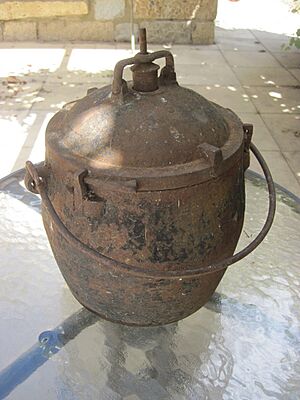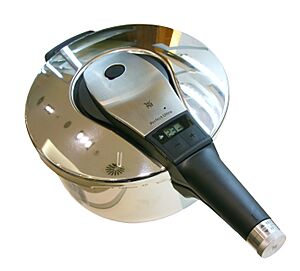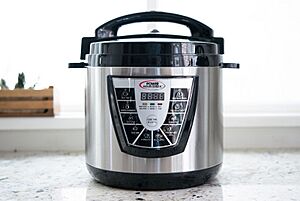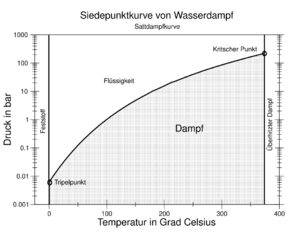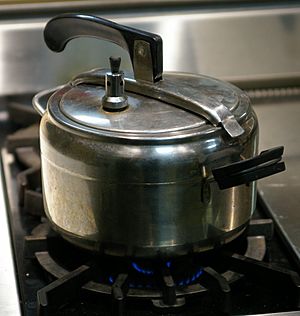Pressure cooking facts for kids
Pressure cooking is a super-fast way to cook food! It uses a special pot called a pressure cooker. Inside this pot, food cooks with hot steam and water. The pot seals tightly, which traps the steam and builds up high pressure. This high pressure makes the water get much hotter than it normally would, so food cooks a lot quicker than in a regular pot.
A French scientist named Denis Papin invented the pressure cooker way back in the 1600s. It works by pushing all the air out and then trapping the steam from the boiling water. This makes the pressure inside the cooker much higher than outside. This higher pressure lets the water get hotter, between 100°C and 121°C (212°F and 250°F). Because it's hotter and the steam transfers heat so well, food cooks two to four times faster! This also saves a lot of energy.
You can cook almost any food in a pressure cooker that you would normally boil or steam. Modern pressure cookers have many safety features to stop them from getting too much pressure. After cooking, the pressure inside is slowly lowered so you can open the pot safely. All new pressure cookers have a safety lock that stops you from opening them while they are still under pressure.
Years ago, in 1950, about 37% of homes in the U.S. had a pressure cooker. By 2011, this number dropped to 20%. Some people were worried about explosions, even though this is very rare with modern cookers. Also, other fast cooking tools like the microwave oven became popular. But newer, "third-generation" pressure cookers are much safer and quieter. They also use digital controls and don't let steam out during cooking. These improvements have made pressure cooking popular again!
Contents
History of Pressure Cookers
In 1679, a French scientist named Denis Papin invented the "steam digester." He wanted to find a way to cook food faster. His special airtight pot used steam pressure to make water boil at a higher temperature. This cooked food more quickly. In 1681, Papin showed his invention to a famous science group in London, and they made him a member!
Later, in 1864, a person named Georg Gutbrod in Germany started making pressure cookers out of a metal called tinned cast iron.
In 1918, a man from Spain, José Alix Martínez, got a patent for his pressure cooker. He called it the "olla exprés," which means "express cooking pot." In 1924, he even published a cookbook with "360 recipes for cooking with a pressure cooker."
In 1935, the Automa pressure cooker came out. Mountain climbers even took it with them when trying to climb Mount Everest. This helped them cook food at very high altitudes.
In 1938, Alfred Vischer showed his "Flex-Seal Speed Cooker" in New York City. This was the first pressure cooker made for homes. It was very successful, and soon other companies in America and Europe started making their own. At the 1939 New York World's Fair, the National Pressure Cooker Company (now called National Presto Industries) showed off their own pressure cooker.
First Generation Pressure Cookers
These are also called "old type" pressure cookers. They have a special valve that "jiggles" or rattles to let out extra steam while cooking. Some people think they are noisy because of this. Older models usually had only one pressure setting. But after the 1960s, some allowed you to change the valve's weight to cook at different pressures.
Many pressure cookers today are still based on these first-generation designs. But they have added new safety features. For example, they have a lock that stops you from opening the cooker until all the pressure is gone.
Second Generation Pressure Cookers
These pressure cookers use a different kind of valve that is often hidden. They usually have two or more pressure settings. Some of these cookers don't let out any steam while they are working. Instead, they have an indicator that rises to show the pressure level. They only release steam if you open the pot or if the heat is too high. Others have a dial you can turn to change the pressure or release steam. These types do release steam during cooking.
Third Generation "Electric Pressure Cookers"
After stovetop pressure cookers, electric pressure cookers arrived in 1991. These are called "third-generation" cookers.
They have their own electric heater that automatically keeps the right temperature and pressure. They also use a hidden valve and usually don't let out steam while cooking.
Electric pressure cookers also have a built-in timer. There are three types of electric pressure cookers:
- First-generation electric: These have a simple mechanical timer. You can't set them to start cooking later.
- Second-generation electric: These have a digital controller. You can set them to start cooking later, and the screen shows a countdown timer once the right pressure is reached.
- Third-generation electric: These are "smart" cookers. They have pre-set cooking times and settings for different foods. They control the heat, temperature, pressure, and how long to cook.
Some pressure cookers can do many things! They are called multicookers. They can be a pressure cooker, a slow cooker, a rice cooker, a food steamer, and more. Since 2018, some pressure cookers can even air fry! These are called "air fryer pressure cookers." They usually have two different lids: one for pressure cooking and one for air frying.
How Pressure Cookers Work
| Pressure (above normal air) | Temperature | Cooking Time (compared to boiling) |
|---|---|---|
| 0 bar (0 psi) | 100 °C (212 °F) | 100% |
| 0.4 bar (5.8 psi) | 110 °C (230 °F) | 50% |
| 1.0 bar (15 psi) | 121 °C (250 °F) | 23% |
Normally, at sea level, water boils at 100 °C (212 °F). When you cook food with water, once it reaches boiling point, any extra heat just turns the water into steam. This keeps the food at 100°C.
But in a sealed pressure cooker, the steam gets trapped. This makes the pressure inside go up. When the pressure goes up, the boiling point of water also goes up! This means the water (and your food) gets much hotter.
For example, if the pressure inside reaches 1 bar (about 100 kPa (15 psi)) above the normal air pressure, the water will reach about 120 °C (248 °F). This much higher temperature cooks food way faster!
Pressure cookers also use steam to transfer heat very quickly to the food. Unlike an oven, which uses air (and air doesn't transfer heat very well), a pressure cooker pushes out the air and fills up with hot steam. When this hot steam touches the cooler food, it turns back into water (condenses). This process releases a lot of heat directly onto the food, making it heat up very fast and evenly.
However, some recipes need food to get a brown crust, like when you roast or fry. This browning happens at much higher temperatures than what a pressure cooker reaches (around 120 °C (248 °F)). So, if you want to brown your food, you usually do it in the open pressure cooker or another pan before you start pressure cooking.
Cooking at High Altitudes
Pressure cookers are super helpful if you live or cook at high altitudes, like in the mountains. At high elevations, the air pressure is lower. This means water boils at a lower temperature. For every 294 meters (about 965 feet) you go up, the boiling point of water drops by about 1°C (1.8°F).
For example, on top of Mount Everest, water would boil at only 70 °C (158 °F)! At such low temperatures, many common vegetables won't cook properly. Charles Darwin wrote about this in his book, The Voyage of the Beagle:
We were now in the republic of Mendoza. The elevation was probably not under 11,000 feet (3,400 m) [...]. At the place where we slept water necessarily boiled, from the diminished pressure of the atmosphere, at a lower temperature than it does in a less lofty country; the case being the converse of that of a Papin's digester. Hence the potatoes, after remaining for some hours in the boiling water, were nearly as hard as ever. The pot was left on the fire all night, and next morning it was boiled again, but yet the potatoes were not cooked.
When you use a pressure cooker at high altitudes, you need to increase the cooking time. Add about 5% more time for every 300 m (980 ft) (about 1,000 feet) above 610 m (2,000 ft) (about 2,000 feet) elevation. Pressure cookers help raise the cooking temperature enough to make food cook properly, and they save fuel by cooking faster.
Some lightweight pressure cookers are made for mountain climbers. They can be as small as 1.5 litres (0.40 US gal) and weigh only 1.28 kilograms (2.8 lb). Sherpas often use pressure cookers at their base camps.
Health Benefits
Pressure cooking can help reduce some harmful substances in food. For example, a study in Korea found that pressure cooking rice could reduce certain toxins (called aflatoxins) to only 32% of what was in the uncooked rice. Regular cooking only reduced them to 77%. Also, because pressure cooking is so fast, many vitamins and minerals in food are kept better than with other cooking methods.
Parts of a Pressure Cooker
Pressure cookers have one or more ways to control the pressure and temperature. All of them have a main pressure release valve and at least one emergency safety valve.
In simpler models, once the right pressure is reached, a valve opens and lets out steam. This keeps the temperature steady. More advanced stovetop models have indicators that show the pressure, so you can turn down the heat to stop steam from escaping. Electric pressure cookers (third generation) automatically control the heat so they usually don't release steam during cooking.
Size
Pressure cookers come in many sizes. A common size holds 6 liters (about 6.3 quarts). But remember, you can't fill a pressure cooker all the way to the top! You can only fill it up to two-thirds full, or even half full for some foods. This is for safety.
The Pot
- The main body of the pot is usually made of metal.
- It has handles, usually one on each side, so you can carry it with both hands.
Pressure cookers are usually heavier than regular pots of the same size because they need to be strong enough to hold high pressure. This extra weight means they aren't great for things like camping where you want to carry light gear. But, as mentioned, there are smaller, lighter ones for mountain climbers.
The Lid
The lid of a pressure cooker has several important parts:
- A lid handle, often with a lock that "clicks" shut. This lock stops you from taking the lid off while the cooker is under pressure.
- A Gasket (also called a "sealing ring"). This rubber or silicone ring makes an airtight seal between the lid and the pot.
- A steam vent with a pressure regulator on top. This is where steam escapes to keep the pressure at the right level.
- A pressure indicator pin. This little pin pops up to show you if there's any pressure inside, even a tiny bit.
- Safety devices. These are extra valves that release pressure if the main one gets blocked or if the pressure gets too high.
The Gasket (Sealing Ring)
The gasket is a rubber or silicone ring that creates a tight seal. It stops air or steam from escaping between the lid and the pot. Steam should only escape through the regulator valve when the cooker is at pressure. If the regulator gets blocked, a safety valve acts as a backup to let steam out.
The gasket needs special care when cleaning. Don't wash it with sharp knives, as they can damage it. You should clean food bits, fats, and oils off the gasket every time you use it. Gaskets usually need to be replaced about once a year, or sooner if they get damaged. If your gasket is very dry, it can be hard to close the lid. Rubbing a tiny bit of vegetable oil on it can help. If the gasket loses its stretchiness, it might be hard for the cooker to build pressure because steam escapes. This usually means you need a new gasket.
Pressure cooker makers sell replacement gaskets and suggest you change them regularly. If a pressure cooker hasn't been used for a long time, the gasket and other rubber parts might dry out and need replacing.
Safety Features
Older pressure cookers had only one safety valve. If food blocked it, there was a risk of explosion. But modern pressure cookers have many safety features to prevent this. If food blocks the steam vent or the liquid boils away, other safety devices will kick in. Modern pressure cookers from good brands are very safe and won't explode. When a safety mechanism releases too much pressure, it can be loud and forceful, and some food might spray out. You can avoid this by cleaning and taking care of your cooker, and by never overfilling it.
New pressure cookers usually have two or three backup safety valves. They also have a lid that locks so you can't open it if there's still pressure inside. This stops hot liquid, steam, and food from suddenly bursting out. You should always read the instruction manual before using a pressure cooker to make sure you use it correctly. If a pressure cooker fails, it can be dangerous because hot steam and water will come out with a lot of force. Because of these dangers, pressure cookers are built very strong and safe. Some countries even have rules to make sure only safe cookers are sold.
For older pressure cookers with a "jiggler" valve, the main safety is a weighted stopper. This stopper lifts up when steam pressure is too high, letting out extra steam. There's also a backup way to release pressure if the main one fails (for example, if food blocks the steam path). One way is a hole in the lid covered by a plug that melts at a low temperature. Another is a rubber ring with a metal piece in the middle. If the pressure gets too high, the ring will push the metal piece out to release pressure. These backup safety devices usually need to be replaced after they are used. Newer pressure cookers might have a spring device that resets itself and releases extra pressure.
On second-generation pressure cookers, a common safety feature is the gasket itself. It can expand to release extra pressure downwards between the lid and the pot. This release is strong enough to put out a gas stove flame!
Pressure cookers sold in the European Union (EU) must follow strict safety rules called the Pressure Equipment Directive.
How Much to Fill
It's important not to overfill your pressure cooker. This stops the steam valve from getting blocked and prevents too much pressure from building up.
- Fill it no more than two-thirds full with solid food.
- Fill it no more than half full for liquids or foods that foam a lot (like rice or pasta). Adding a tablespoon of cooking oil can help stop foaming.
- Fill it no more than one-third full for beans or lentils.
Accessories
- A steamer basket to cook food above the liquid.
- A trivet (a small stand) to keep the steamer basket above the liquid.
- A metal divider to separate different foods in the steamer basket (like different vegetables).
- An inner pot for "pot-in-pot" cooking.
Pressure cookers are usually made of aluminum or stainless steel. Aluminum ones are cheaper but can react with acidic foods, changing their flavor. They are also less durable and can't go in the dishwasher.
Higher-quality stainless steel pressure cookers have thick, layered bottoms (sometimes with copper) to spread heat evenly. Most modern stainless steel cookers can go in the dishwasher, but some makers suggest washing by hand. Some pressure cookers also have a non-stick coating inside.
How to Use a Pressure Cooker
Adding Liquid
You always need a water-based liquid in a pressure cooker to make the steam. You can't use a pressure cooker for cooking methods that don't make much steam, like roasting or deep frying. Your cooker's manual will tell you the minimum amount of liquid needed. For cookers that vent steam, you'll need more liquid for longer cooking times.
When cooking beans, don't fill the inner pot more than halfway.
Putting it Together
Put your food inside the pressure cooker with a little water or other liquid like broth. You can cook food directly in the liquid or use a steamer basket to cook it above the liquid. Steaming keeps the flavors of the food separate from the liquid.
Sauces that have thickeners like starch can burn onto the bottom of the pressure cooker. This might stop the cooker from reaching the right pressure. So, you might need to thicken your sauces after pressure cooking.
With "pot in pot" cooking, you put some or all of your food in a smaller pot, which then sits on a stand (trivet) inside the pressure cooker. This smaller pot sits above the water or other food that makes the steam. This way, you can cook different foods separately, use less water with your food, and make thicker sauces without them burning.
Building Pressure
Close the lid, choose your pressure setting, and heat the pressure cooker. The liquid will boil, and the cooker will fill with steam, pushing out the air. As the temperature inside rises, the pressure goes up until it reaches the level you want.
It usually takes a few minutes for the pressure cooker to reach full pressure. This can take longer if you have a lot of food, if the food is cold or frozen, if you have a lot of liquid, or if your stove isn't very powerful. There's usually a pop-up indicator that shows when there's pressure inside, but it doesn't always mean it's at full cooking pressure. This indicator mostly shows that the lid is locked and can't be opened.
You start timing your recipe when the cooker reaches the correct pressure. Once it's at full pressure, turn down the heat to the lowest setting that still keeps the pressure steady. Using too much heat wastes energy and makes you lose more liquid. It's very important to use a timer when pressure cooking.
For first-generation cookers, the pressure regulator (the "jiggler") will start to lift and let out extra steam. In second-generation cookers, a valve opens to release steam, or a rod rises to show the pressure level without constantly venting steam. At this point, you lower the heat. Third-generation electric cookers will sense when they're at the right temperature and pressure and will keep it there for the set time, usually without losing more steam.
Some recipes, like steamed puddings, ask you to gently steam them without pressure first. This helps activate the ingredients that make them rise, so they become light and fluffy.
Using Food Containers
You can use small containers, like plastic pudding containers, inside a pressure cooker. Just make sure they (and any covers) can handle temperatures up to 130 °C (266 °F) (266°F) and aren't placed directly on the bottom of the cooker. These containers are good for foods that might burn on the bottom of the pot. If you use a lid on the container, make sure some steam can still get to the food. For example, you can use foil or greaseproof paper, folded in the middle and tied with string. Don't use cracked or damaged containers. Cooking time will be longer when using covered containers because the food isn't directly touching the steam. Also, non-metal containers don't conduct heat as well, so if a recipe calls for a metal container, don't swap it for plastic or glass without increasing the cooking time. Thicker containers, like oven-safe glass, will add about 10 minutes to the cooking time. You can add liquid inside the container for foods like rice that need to soak up water to cook.
Browning Ingredients
You can make some foods, like meat and onions, taste better by browning them first. You do this by gently cooking them with a little oil or butter in the open pressure cooker over medium heat (if your cooker allows it). Don't overheat an empty pressure cooker, and never heat it with the lid and gasket on, as this can cause damage. Electric pressure cookers usually have a "saute" or "brown" setting for this. After browning, let the cooker cool down briefly before adding liquid. If you add liquid too soon, some will evaporate instantly, and you might not have enough for the whole pressure cooking time.
How to Release Pressure
After cooking, there are three ways to release the pressure before you can open the lid. Recipes will tell you which method to use for the best results. If you don't follow the recommendation, your food might be undercooked or overcooked.
To avoid opening the pressure cooker too often when cooking different vegetables, you can cut vegetables that take longer to cook into smaller pieces. Vegetables that cook faster can be cut into larger pieces.
With a regular pot, you can just lift the lid to check your food. But with a pressure cooker, you have to release the pressure first, which stops the cooking.
Manual Release (Quick Release)
This method is sometimes called a "quick release" (but it's different from the cold water release). You slowly lift or remove the valve, push a button, or turn a dial to let the steam out quickly. This is best if you need to stop cooking to add food that cooks faster than what's already in the pot. For example, you might add vegetables to a stew later so they only cook for the last few minutes. Be careful when releasing steam to avoid getting burned. This method is not good for foods that foam a lot, like beans or rice, because the hot food might spray out of the vent. It takes about two minutes to release the pressure this way.
Natural Release
The natural release method lets the pressure drop slowly on its own. You just take the pressure cooker off the heat and let it cool down. It takes about 10 to 15 minutes (or longer) for the pressure to go away. On many pressure cookers, a colored pin will drop when the pressure is gone. This method is best for foods that foam a lot, like rice or beans, or for recipes with ingredients that make them rise, like steamed puddings. Using natural release can also make meat more tender. This method continues to cook the food slightly because the cooker stays hot. So, it's not good for foods that cook very quickly, as they might overcook.
Cold Water Quick Release
This is the fastest way to release pressure for stovetop pressure cookers, but it can be risky if not done right. It's usually safer to use the other methods. Your cooker's manual might warn against this method or tell you how to do it safely.
To do this, you run a slow stream of cold tap water over the edge of the pressure cooker lid. Be very careful to avoid the steam vent or any other valves. Never put the whole pressure cooker under water! If you do, steam can shoot out from under the lid and burn you. Also, if water gets sucked into the cooker, it can create a vacuum and permanently damage the lid.
The cold water release is best for foods that cook very quickly. It takes about 20 seconds for the cooker to cool down enough to open safely. This method doesn't work for electric pressure cookers because you can't put them under water.
This method is not recommended for cooking beans or other pulses, as the sudden pressure change can make their skins burst.
Pressure Settings
Most pressure cookers cook at a pressure between 0.8 and 1 bar (11.6 and 15 psi) above normal air pressure. The standard cooking pressure of 15 psi was set in 1917. At this pressure, water boils at 121 °C (250 °F) (250°F).
This higher temperature makes food cook much faster. Cooking times can be as little as one-third of what they would be with regular cooking. The actual cooking time also depends on how you release the pressure, and how thick or dense the food is. Thicker foods take longer. Large pieces of meat and some puddings are timed by their weight. Frozen foods need extra cooking time to thaw.
When cooking at 1 bar/15 psi, shredded cabbage might take one minute, boiled potatoes (cut small) about seven minutes, and fresh green beans about three minutes. If you use natural release, cooking times can be even shorter. Cutting food into smaller pieces also helps it cook faster.
Some recipes, like for fresh vegetables, might ask you to cook at a lower pressure than 1 bar/15 psi, because they can easily overcook. Many pressure cookers have 2 or more pressure settings.
If your pressure cooker operates at a lower maximum pressure than a recipe suggests, you can just increase the cooking time to make up for it.
Efficiency
Pressure cookers are usually more expensive than regular pots of the same size.
They use much less water than boiling, which means food heats up faster and uses less energy. You also don't need to completely cover food in water. For cookers that don't vent steam, once they reach pressure, no steam escapes, so no water is lost through evaporation. Overall, electric pressure cookers can use up to 70% less energy than cooking in a regular pan.
Effect on Food
Pressure cooking uses much less water than boiling, so food is ready sooner.
Because of this, vitamins and minerals don't get dissolved and washed away by a lot of water, as they would if you boiled food in large amounts of water. The shorter cooking time also helps keep vitamins in the food.
You can cook several foods together in a pressure cooker. You can cook them all for the same amount of time, or add some later if they cook faster. Manufacturers often provide steamer baskets to help you cook different foods at once.
The hot steam in a pressure cooker not only cooks food quickly but also kills tiny living things (micro-organisms) very effectively. This means a pressure cooker can be used to clean things like jam jars or glass baby bottles, or even to make water safe to drink when camping.
Foods Not Good for Pressure Cooking
Some foods are not recommended for pressure cooking. Foods like noodles, pasta, cranberries, cereals, and oatmeal can expand too much, foam, and sputter. This can block the steam vent and create an unsafe situation.
Related Cooking Tools
An autoclave is like a super-strong pressure cooker used in labs and hospitals. It gets very hot (≥ 121 °C or 250°F) to sterilize (clean completely) equipment. A "stovetop autoclave" is a simpler, high-pressure cooker used for sterilizing in places where fancy equipment isn't available.
Pressure canners are large pressure cookers designed to hold jars for home canning. They are specially made for canning and can hold heat (≥ 115 °C or 239°F) and pressure for much longer than regular pressure cookers. This is very important to destroy harmful germs and prevent botulism poisoning. Regular pressure cookers are not recommended for canning.
Pressure fryers are used for deep-frying food under pressure. Regular pressure cookers are not safe for pressure frying.
An air fryer pressure cooker is a new combination of a pressure cooker and an air fryer. It has two separate lids: one for pressure cooking and one for air frying. The air frying lid has a fan inside that lets it air fry foods, just like a regular air fryer. The Ninja Foodi Pressure Cooker helped make this idea popular.
A pressure oven is a mix of an oven and a pressure cooker, usually for your kitchen counter. Pressure ovens work at lower pressures (about 10 kilopascals (1.5 psi)) compared to other pressure cookers. They are mainly used to cook meat and poultry, keeping them from drying out. They often have a rotisserie (a spinning spit). While they don't have enough pressure for most regular pressure cooking, they can also work as normal ovens.
See also
- List of cooking appliances
Images for kids



